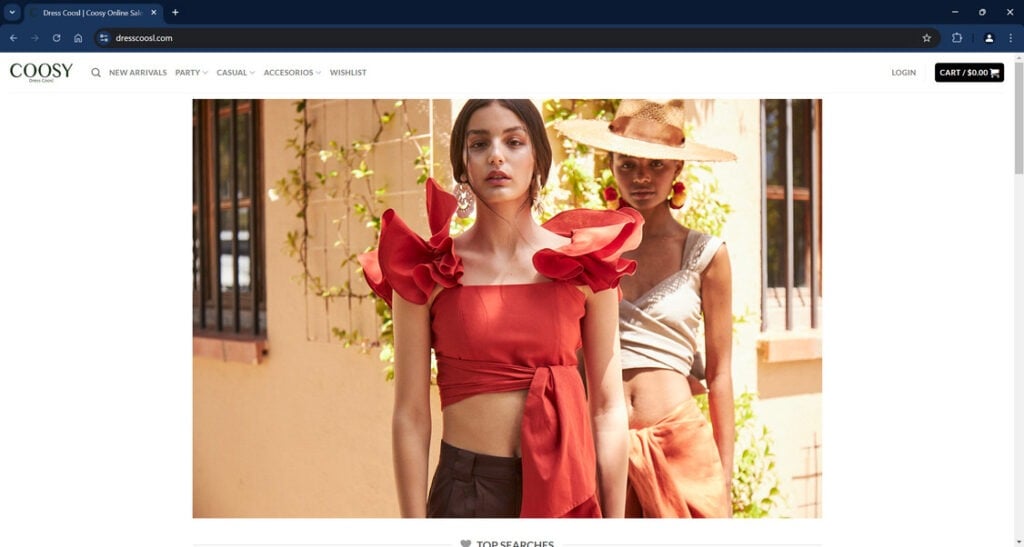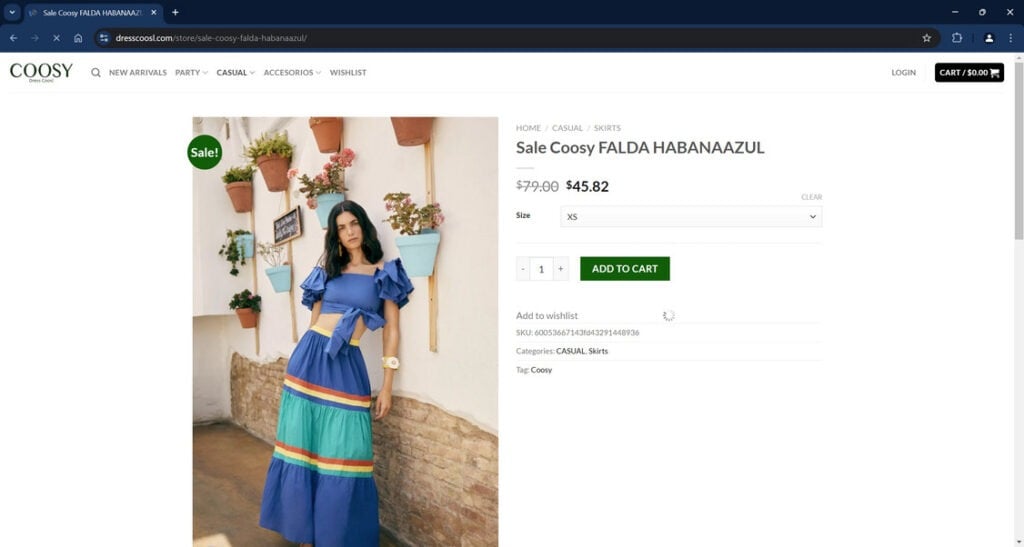Online shoppers are being targeted by an insidious new scam involving fake Coosy branded websites offering clearance sales with up to 90% off. This compelling bait hooks in bargain hunters, only to leave them out of pocket when the advertised goods never arrive.
In this article, we’ll break down exactly how the Coosy clearance scam works, provide tips on how to spot a fraudulent website, and advise you on what to do if you’ve already fallen victim.

Overview of the Scam
The Coosy clearance scam exploits the popularity of the Spanish fashion brand Coosy and the irresistible draw of extreme discounts. Fraudsters set up fake e-commerce websites using the Coosy name, branding, and images of Coosy products.
These fake sites advertise clearance sales with up to 90% off, using slogans like “Outlet Sale”, “Warehouse Clearance”, “Store Closing Down Sale”, and “Limited Time Offer” to create urgency. The scam sites accept payment by credit card or PayPal, but simply take customers’ money without ever shipping the purchased items.

This con is being promoted through targeted ads on social media platforms like Facebook, Instagram and TikTok. The ads direct shoppers to the fraudulent sites, making the scam appear more legitimate. Unsuspecting bargain hunters are being hooked in and ripped off in huge numbers.
How the Coosy Clearance Scam Works
Let’s break down the exact steps of how this scam ensnares its victims:
1. Fraudulent Sites Set Up
The scammers first set up fake e-commerce websites claiming to sell Coosy products. These sites use the Coosy logo, images of Coosy clothing copied from the real website, and Coosy in the domain name. However, they are not affiliated with the real company in any way.
2. Fake Discounts Advertised
The fake sites prominently advertise clearance sales with up to 90% off original prices. Many use enticing slogans like “Closing Down Sale” or “Limited Time Deals” to create a false sense of urgency. Prices on the scam sites are very low, such as $29, $39 or $49 per item.
3. Social Media Ads Promote the Scam
The fraudsters then take to social platforms like Facebook, Instagram and TikTok to promote their scam sites. They run ads targeted at users who have shown interest in fashion and clothing deals. The ads direct viewers to the fake Coosy sites.
4. Shoppers Hooked By Extreme Discounts
When social media users click on these ads, they are taken in by the seemingly amazing discounts on a well-known brand like Coosy. Thinking they are getting designer clothes for 90% off, many will place orders on the fake sites.
5. Payment Processed, No Order Shipped
Whether paying by credit card or PayPal, victims’ payments are accepted on the fraudulent sites. However, nothing is ever shipped to the customer.
6. No Recourse, Money Lost
At this point, the customers have no way to contact the “company” beyond a dubious email address. With no phone number, physical address or real point of contact, victims cannot get their money back. The scammers pocket the payments and move on to the next victim.
How to Spot Fake Coosy Websites Running the Clearance Sale Scam
Fraudsters have become adept at making their scam websites look authentic, but there are key signs to watch for:
Newly Registered Domains
Fake sites often use newly registered domains, registered just days or weeks before the scam promotion begins. For example, a current scam site uses the domain “coosyoutlet.shop” which was registered less than a month ago. Always research when a domain was first registered using a tool like Whois.com.
No Contact Information Other Than an Email
Scam sites will often only provide an email address for contact, lacking phone numbers or a physical address. Emails associated with the domain name are also suspicious, for example support@coosyoutlet.shop. Genuine retailers will display full contact details.
Extreme Discounts of 90% or More
Beware of any site offering discounts of 90% off or more on a mainstream brand’s products. This is an immediate red flag signaling a scam. Authentic brands do not offer such extreme sales.
Template Website Design
Scam websites often use copied template designs which appear generic. Look for limited customization beyond inserting the brand name. Unique, tailored designs are a sign of an authentic retailer investing in their site.
Plagiarized Content and Images
Scammers steal product descriptions, web copy, and images from the real brand’s site and social channels. Identical product photos or text copied word-for-word indicates fraud.
Slogans Promising Huge Savings
Phrases like “90% Off Warehouse Clearance”, “Store Closing Down Sale” or “Limited Time Deals” are go-to slogans for scam sites. If something urges you to act fast for major savings, treat it as suspicious.
How to Spot the Coosy Outlet Scam on Social Media
How to Spot the Coosy Scam on Facebook
Watch for Facebook ads promoting Coosy with:
- Prices too good to be true like $29 or 90% off
- Enticing slogans like “Warehouse Clearance Sale”
- Links to sketchy sites you’ve never heard of
- Limited time offers urging you to act fast
- Layout and images that look unofficial
For example, one scam Facebook ad shows a model wearing a Coosy sweater with the text “Our Warehouse is Closing! Coosy Knit Sweaters Just $29.” The ad links to a site called “coosywearhouse[dot]store.” This is a major red flag signaling a fraudulent ad – avoid engaging with it.
How to Spot the Coosy Scam on Instagram
Be suspicious of Instagram posts and Stories promoting Coosy goods with:
- Unbelievable prices like a $49 coat or blanket
- Suspicious slogans like “Going Out of Business Sale”
- Tagging strange accounts rather than @coosyofficial
- Countdown timer graphics urging you to shop
- Comment sections turned off
For example, a post shows a Coosy purse “On Sale NOW for $29!” and tags @coosy_outlet rather than the real @coosyofficial account. The comment section is disabled and there’s a 24-hour countdown. This is spam from a fake account – don’t shop from it.
How to Spot the Coosy Scam on TikTok
Avoid TikTok videos advertising Coosy products with:
- Huge discounts like 90% off or $39 items
- Vague claims like “Today Only Wharehouse Sale!”
- Links in bios to unfamiliar sites
- Repurposed footage that looks unofficial
- Desperate pleas to “Hurry, order now!”
For instance, a TikTok shows Coosy shoes on sale for $29 and says “Final hours of our Blowout Sale! Tap to shop!” – but links to coosyshopdeal[dot]com. This violates brand guidelines and signals a scam. Do not click the link or purchase.
What To Do If You Are Scammed
If you have placed an order on a fake Coosy site and suspect you’ve been scammed, take the following steps right away:
- Contact your bank or credit card provider to report the fraudulent charge and request a chargeback. This reverses the transaction and refunds your money.
- Report the scam to the FBI’s Internet Crime Complaint Center at www.ic3.gov. Provide details of the transaction and fake site.
- Warn others by leaving negative reviews about the scam site on consumer sites like Trustpilot. Spread awareness to help others avoid being stung.
- Check your credit report to ensure no accounts have fraudulently been opened in your name. Consider freezing your credit to prevent this.
- Secure other online accounts that used the same password. Change passwords and enable two-factor authentication everywhere possible.
- Watch for other fraud like phishing emails or calls. Scammers often target those already stung, seeking more money or data.
Frequently Asked Questions About the Coosy Clearance Sale Scam
1. What is the Coosy clearance sale scam?
The Coosy clearance scam involves fake ecommerce websites that falsely claim to sell Coosy products at up to 90% off in warehouse or closing down sales. This scam is promoted via targeted ads on social media. After taking victims’ money, the sites never deliver any products.
2. How does the Coosy clearance scam work?
The scammers set up fake sites with the Coosy name and branding. They advertise huge discounts of up to 90% off using slogans like “closing down sale” to create urgency. Social media ads direct people to the fraudulent sites. Shoppers are fooled by the discounts and place orders. The sites take their money but never ship anything.
3. What are some red flags of a fake Coosy website?
Red flags include unbelievable discounts like 90% off, recently registered domains, no contact info beyond an email, no social media presence, template site design, poor grammar/spelling, and only taking credit cards or PayPal. Legitimate retailers will not offer such large discounts.
4. What should I do if I ordered from a fake Coosy site?
If you placed an order on a scam site, contact your bank/credit card company immediately to dispute the charges. Report the fraud to the FBI IC3. Leave negative reviews about the site to warn others. Check your credit report for any opened accounts. Change any passwords you used on the site.
5. How can I get my money back if I was scammed?
Your best recourse is requesting a chargeback from your credit card provider or bank. This reverses the transaction and refunds your money. Provide details of the fraudulent transaction. Act quickly, as chargeback time limits apply.
6. Should I report the fake Coosy website?
Absolutely. Report the site to the FBI’s Internet Crime Complaint Center at www.ic3.gov. The more reports they receive about a scam site, the quicker authorities can shut it down to prevent more victims. Include site details and transaction info.
7. How can I avoid the Coosy clearance scam?
Avoid deals that seem too good to be true, like 90% off a mainstream brand. Research unfamiliar sites and read reviews. Beware of new domains and lack of contact info. Use secure payment methods that offer buyer protection. If you spot any red flags, do not make a purchase.
8. How can I spot a fake Coosy website or ad?
Look for red flags like prices that are too low, template site designs, no social media presence, payment by only credit card/PayPal. Fake sites often have grammar errors, lack transparency around owners, and use enticing slogans about closing down or clearance sales. Verify the domain age.
9. Are the ads for Coosy sales on social media real?
Likely not. Scammers are running fake Coosy ads on Facebook, Instagram and TikTok to direct people to their fraudulent sites. Don’t click on social media ads with too good to be true offers. Check site details carefully before purchasing anything.
10. How can I protect myself from online shopping scams?
Research unfamiliar sites, read reviews, look for red flags, avoid too-good-to-be-true deals, use credit cards instead of direct bank transfers, inspect sites for contact details and transparency, and don’t fall for pressured sales tactics like limited time offers.
The Bottom Line
The Coosy clearance scam takes advantage of bargain seekers through enticing but fraudulent offers. While the extreme discounts are highly tempting, recognising the warning signs can save you from losing money. If you unfortunately do fall victim, act quickly to report the fraud, secure your accounts, and claw back stolen funds.
Spreading awareness is key to protecting others and shutting down these scam sites faster. Being an informed consumer and closely evaluating deals that seem too good to be true go a long way in avoiding online scams. Approach online shopping with caution, and use secure payment methods to minimize risks.










